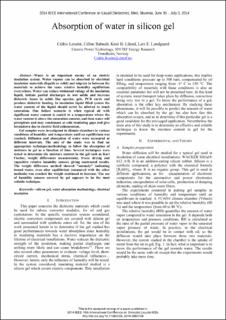| dc.contributor.author | Lesaint, Cedric Michel | |
| dc.contributor.author | Babault, Celine | |
| dc.contributor.author | Liland, Knut Brede | |
| dc.contributor.author | Lundgaard, Lars Esben | |
| dc.date.accessioned | 2024-02-22T12:30:47Z | |
| dc.date.available | 2024-02-22T12:30:47Z | |
| dc.date.created | 2014-10-09T17:01:19Z | |
| dc.date.issued | 2014 | |
| dc.identifier.citation | 2014 IEEE 18th International Conference on Dielectric Liquids ICDL | en_US |
| dc.identifier.isbn | 9781479920655 | |
| dc.identifier.uri | https://hdl.handle.net/11250/3119362 | |
| dc.description.abstract | Water is an important enemy of an electric insulation system. Water vapour can be absorbed by electrical insulation materials (liquids or solid) and migrate in between the materials to achieve the same relative humidity equilibrium everywhere. Water can reduce withstand voltage of the insulation liquid, initiate partial discharges in wet solids and increase dielectric losses in solids like epoxies, gels, PCB cards and produce dielectric heating. In insulation liquid filled system the water content of the liquid should never be allowed to reach saturation. One failure scenario is when typical oil with significant water content is cooled to a temperature where the water content is above the saturation content, and then water will precipitate and may condensate at cold insulating gaps and give breakdown due to electric field enhancement. Gel samples were investigated in climate chambers in various conditions of humidity and temperature until an equilibrium was reached. Diffusion and absorption of water were measured at different intervals. The aim of the study was to find an appropriate technique/methodology to follow the absorption of moisture in gel as a function of time. Several techniques were tested to determine the moisture content in the gel such as Karl Fischer, weight differences measurement, freeze drying and capacitive relative humidity sensors giving contrasted results. The weight difference method showed “anomaly” indicating bound water, even after equilibrium (measured with the other methods) was reached the weight continued to increase. The use of humidity sensors covered by gel appears to be the most reliable technique. | en_US |
| dc.description.abstract | Absorption of water in silicon gel | en_US |
| dc.language.iso | eng | en_US |
| dc.publisher | IEEE | en_US |
| dc.relation.ispartof | 2014 IEEE 18th International Conference on Dielectric Liquids ICDL | |
| dc.title | Absorption of water in silicon gel | en_US |
| dc.title.alternative | Absorption of water in silicon gel | en_US |
| dc.type | Chapter | en_US |
| dc.type | Peer reviewed | en_US |
| dc.description.version | acceptedVersion | en_US |
| dc.identifier.cristin | 1162815 | |
| dc.relation.project | Norges forskningsråd: 215584 | en_US |
| cristin.ispublished | true | |
| cristin.fulltext | postprint | |
